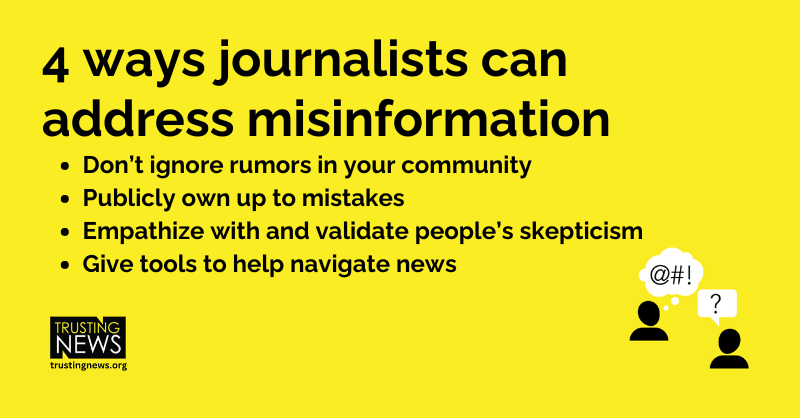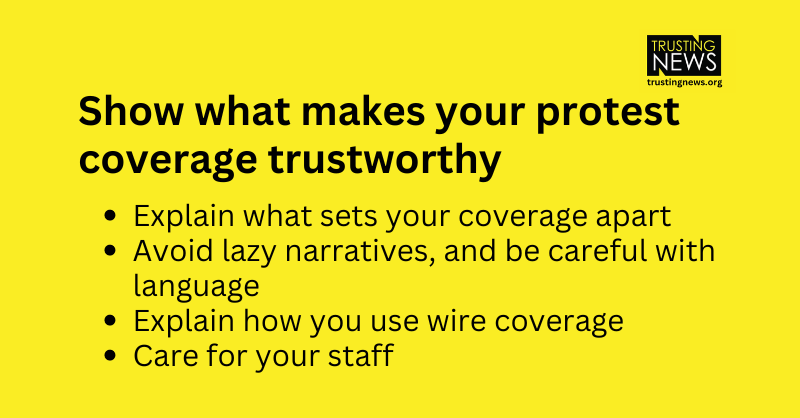
Note: This is the third installment of a three-part newsletter series on News Avoidance. Read part one, Learn about news avoiders with this guide, and part two, Tell news avoiders these things about your journalism. As journalists, our news habits are not at all normal. We tend to be tuned in all the time. We […]
Adapt your products for news avoiders in three ways
Note: This is the third installment of a three-part newsletter series on News Avoidance. Read part one, Learn about news avoiders with this guide, and part two, Tell news avoiders these things about your journalism.
As journalists, our news habits are not at all normal. We tend to be tuned in all the time. We have deep contextual knowledge of a lot of topics. We typically know the major players in a story. Part of being an expert for our communities calls for this level of investment and understanding.
Yet the way many journalists present news expects the same level of investment from the general public. We produce coverage that assumes people have a certain level of prior knowledge. We set an expectation that people should be tuned into all the alerts on all the platforms.
Even newsroom’s daily newsletters are sometimes branded as “catch-ups,” as if to infer someone who isn’t tuned into the 24-hour news cycle multiple times a day needs catching up. Think about that. It used to be common to read a morning newspaper or watch the evening news, and that habit was a sufficient one. Now we treat *only* consuming news once a day as a catch-up opportunity.
While your community does include news fanatics, it also likely includes a large (and growing) audience that isn’t being served by this type of coverage.
In our recent program around confronting news avoidance, newsrooms in the cohort heard this sentiment from people in their communities. People felt very overwhelmed by the news, both by its volume and content. These news avoiders told our partner journalists that they wanted news that felt more basic — and as one newsroom put it, simply helped people “with important civic processes.”
How can we as journalists better meet people where they are? How can we adjust and repackage our coverage to feel more accessible and less overwhelming? How can we create easier access points to news so people feel like they only need to spend a few minutes a day to feel caught up?
Our team at Trusting News is excited to continue thinking about and experimenting with, from a product and content standpoint, how journalists might start addressing these questions.
In today’s newsletter, we’re highlighting some examples of news formats we’d love to see more of.
1. Prioritize relevant, high-utility content
Start by getting curious about whether you’re actually providing information that would serve the people who are avoiding news. How do they access information? What do they need?
In our recent program, newsroom partners heard that people filtered news based on topics they felt were relevant to their lives. People were willing to (and said they did) engage with news that resonated with them and felt useful to their daily lives. So what can that look like?
We love this former Teach Me How to Texas newsletter from the Texas Tribune. It’s no longer active, but we’d love to see it copied! The pop-up newsletter series was about how people could participate in public life in Texas. It wasn’t really promoted as much as a news product, but instead was focused on how it could solve a problem for those new to the state (or new to civic life) by demystifying how the process worked.

2. Make the news feel more accessible
Far too often, news coverage assumes people have a certain level of knowledge or buy-in with a topic. This can perpetuate the feeling that the news is made for certain groups of people — often, the already engaged. And that, research shows, causes the less engaged to further tune out.
People shouldn’t need to be experts or political fanatics to understand news. But often, the news feels like an insider’s game, full of jargon and missing context. If you’re not already an paying close attention, daily journalism is too often just not designed for you to comprehend.
This accessibility is also something we should be examining when thinking about the delivery of news. As one newsroom in our recent program noted, literacy is a huge gap for people, with one news avoider they talked to saying they had trouble reading but consumed a lot of audio content.
What are newsrooms doing to offer news that feels approachable and accessible? Here are some ideas.
- Axios’ Smart Brevity format is an example of how to present news in a way that helps readers understand and absorb news quickly.
- The Saha Journal serves immigrant communities and created an audio newsletter and offers news in multiple languages.
- ABC10 in Sacramento has been producing short (1–2 minute) videos that explain each of the propositions on the California ballot, airing the videos on TV and posting them to YouTube to make them accessible and easy to share on social.
- The LAist created their voter guide so someone would be able to use it to vote with no prior knowledge. It’s written in a conversational tone and most of the information is offered in bullet points.
3. Help people feel easily caught up
Many people are interested in getting news that gives them the key highlights of what they really need to know so they can move on with their busy lives — news avoider or not.
We as journalists could absolutely step up and provide a service by simplifying news and reducing complexity.
This could look like a weekly top headline type of newsletter, podcast, bullet point stories or quick explainers — anything that makes it easier for people to feel in the loop and caught up without having to sacrifice a lot of time or come in with a lot of prior engagement.
Here are some examples of how that could look:
- News Not Noise. Jessica Yellin’s newsletter and social feeds are both geared to provide easily digestible news in quick snippets.
- Wirecutter often breaks up their content by making things scannable and putting a lot of information in expandable/contractable boxes.
- The Christian Science Monitor offers a quick read/deep read option on certain stories, and lets readers know how long it would take to read the deep read version. (We wrote recently about how we audited the Monitor’s trustworthiness.)
AI solutions have the potential to really help here as well. What if you could ask for additional context or background material to be added to a story? Perhaps a story could include a toggle or slider to indicate how much previous knowledge you’re arriving with?
Or what if you could ask to get caught up to speed on a specific topic over a specific period of time. Like … I follow local school news but have been tuned out for three weeks. What have I missed? Or … I’m interested in Congress and climate change and just got back from a week’s vacation. Catch me up.
More resources on news avoidance
- Re-watch our webinar with Dr. Benjamin Toff, who recently co-authored the book “Avoiding the News”
- Confront news avoidance with these three strategies
- Resource: News Avoider Interview Guide
We’re continuing this work
This is the last in a three-part Trust Tips series on what we learned during our Confronting News Avoidance cohort. Helping journalists confront news avoidance is a priority for us in 2024, and we’re excited to continue learning alongside journalists like you.
If you’re interested in this work, we’d love to connect with you! We’d also be thrilled to see examples of how you’re addressing news avoidance already. Reach out to our team on LinkedIn, X or email at info@trustingnews.org.
At Trusting News, we learn how people decide what news to trust and turn that knowledge into actionable strategies for journalists. We train and empower journalists to take responsibility for demonstrating credibility and actively earning trust through transparency and engagement. Subscribe to our Trust Tips newsletter. Follow us on Twitter and Facebook. Read more about our work at TrustingNews.org.

Project manager Mollie Muchna (she/her) has spent the last 10 years working in audience and engagement journalism in local newsrooms across the Southwest. She lives in Tucson, Arizona, where she is also an adjunct professor at the University of Arizona’s School of Journalism. She can be reached at mollie@trustingnews.org and on Twitter @molliemuchna.





